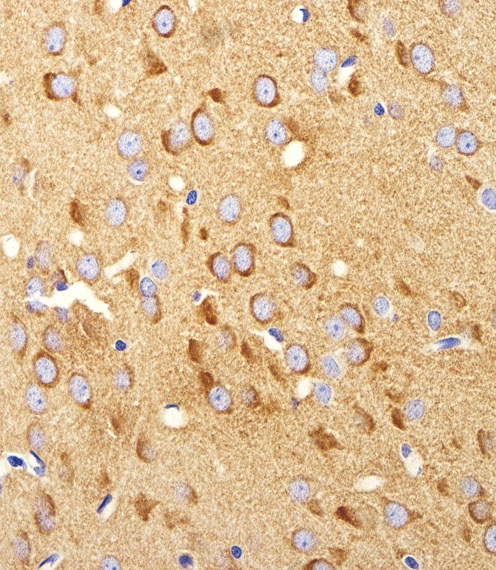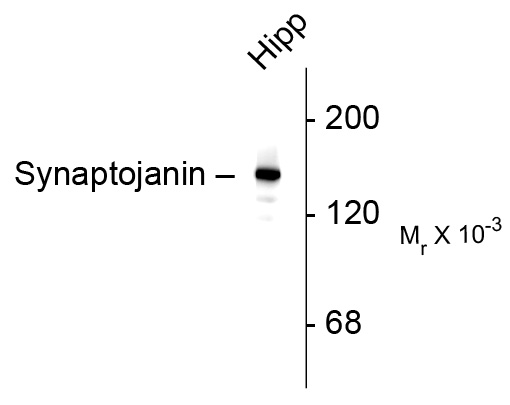Synaptojanin I Antibody
Purified mouse monoclonal antibody
- SPECIFICATION
- CITATIONS
- PROTOCOLS
- BACKGROUND

Application
| IHC, WB |
|---|---|
| Primary Accession | Q62910 |
| Reactivity | Rat |
| Host | Mouse |
| Clonality | monoclonal |
| Isotype | IgG1 |
| Clone Names | 5H1 |
| Calculated MW | 145 KDa |
| Gene ID | 85238 |
|---|---|
| Gene Name | SYNJ1 |
| Other Names | Synaptojanin-1, Synaptic inositol 1, 5-trisphosphate 5-phosphatase 1, Synj1 |
| Target/Specificity | Recombinant protein from the C-terminal region of rat synaptojanin 1. |
| Dilution | IHC~~1:100 WB~~ 1:1000 |
| Format | Protein G purified culture supernatant. |
| Antibody Specificity | Specific for the ~145k synaptojanin I protein in Western blots of rat brain extracts. Immunolabeling blocked by preadsorption of antibody with the protein used to generate the antibody. |
| Storage | Maintain refrigerated at 2-8°C for up to 6 months. For long term storage store at -20°C in small aliquots to prevent freeze-thaw cycles. |
| Precautions | Synaptojanin I Antibody is for research use only and not for use in diagnostic or therapeutic procedures. |
| Shipping | Blue Ice |

Thousands of laboratories across the world have published research that depended on the performance of antibodies from Abcepta to advance their research. Check out links to articles that cite our products in major peer-reviewed journals, organized by research category.
info@abcepta.com, and receive a free "I Love Antibodies" mug.
Provided below are standard protocols that you may find useful for product applications.
Background
Synaptojanin is a phosphatidylinositol phosphatase involved in clathrin-mediated endocytosis of synaptic vesicles. Synaptojanin 1 has two alternatively spliced isoforms; one that is ~ 145 kDA and is exclusively expressed in neurons, and the other ~ 170 kDa which is expressed in non-neuronal, peripheral tissues (Ramjaun AR & McPherson PS, 1996). The gene which encodes Synaptojanin 1, SYNJ1, has been mapped to chromosome 21 thus making it a candidate for involvement in Down’s syndrome (DS). It has recently been demonstrated that Ts65Dn mice (the most commonly used model of DS) have altered phosphatidylinositol-4,5-bisphosphate metabolism. This defect is rescued by restoring SYNJ1 to disomy in the Ts65Dn mice (Voronov SV et al., 2008).
References
Tissue-specific alternative splicing generates two synaptojanin isoforms with differential membrane binding properties (1996). Ramjaun AR, McPherson PS. J Biol Chem. Oct 4;271(40):24856-61.
Synaptojanin 1-linked phosphoinositide dyshomeostasis and cognitive deficits in mouse models of Down's syndrome (2008) .Voronov SV, Frere SG, Giovedi S, Pollina EA, Borel C, Zhang H, Schmidt C, Akeson EC, Wenk MR, Cimasoni L, Arancio O, Davisson MT, Antonarakis SE, Gardiner K, De Camilli P, Di Paolo G. Proc Natl Acad Sci U S A. Jul 8;105(27):9415-20.
If you have used an Abcepta product and would like to share how it has performed, please click on the "Submit Review" button and provide the requested information. Our staff will examine and post your review and contact you if needed.
If you have any additional inquiries please email technical services at tech@abcepta.com.













 Foundational characteristics of cancer include proliferation, angiogenesis, migration, evasion of apoptosis, and cellular immortality. Find key markers for these cellular processes and antibodies to detect them.
Foundational characteristics of cancer include proliferation, angiogenesis, migration, evasion of apoptosis, and cellular immortality. Find key markers for these cellular processes and antibodies to detect them. The SUMOplot™ Analysis Program predicts and scores sumoylation sites in your protein. SUMOylation is a post-translational modification involved in various cellular processes, such as nuclear-cytosolic transport, transcriptional regulation, apoptosis, protein stability, response to stress, and progression through the cell cycle.
The SUMOplot™ Analysis Program predicts and scores sumoylation sites in your protein. SUMOylation is a post-translational modification involved in various cellular processes, such as nuclear-cytosolic transport, transcriptional regulation, apoptosis, protein stability, response to stress, and progression through the cell cycle. The Autophagy Receptor Motif Plotter predicts and scores autophagy receptor binding sites in your protein. Identifying proteins connected to this pathway is critical to understanding the role of autophagy in physiological as well as pathological processes such as development, differentiation, neurodegenerative diseases, stress, infection, and cancer.
The Autophagy Receptor Motif Plotter predicts and scores autophagy receptor binding sites in your protein. Identifying proteins connected to this pathway is critical to understanding the role of autophagy in physiological as well as pathological processes such as development, differentiation, neurodegenerative diseases, stress, infection, and cancer.



